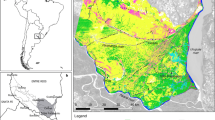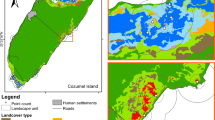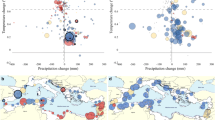Abstract
We assessed changes in vegetative structure of 49 impoundments at Moosehorn National Wildlife Refuge (MNWR), Maine, USA, between the periods 1984–1985 to 2002 with a multivariate, adaptive approach that may be useful in a variety of wetland and other habitat management situations. We used Mahalanobis Distance (MD) analysis to classify the refuge’s wetlands as poor or good waterbird habitat based on five variables: percent emergent vegetation, percent shrub, percent open water, relative richness of vegetative types, and an interspersion juxtaposition index that measures adjacency of vegetation patches. Mahalanobis Distance is a multivariate statistic that examines whether a particular data point is an outlier or a member of a data cluster while accounting for correlations among inputs. For each wetland, we used MD analysis to quantify a distance from a reference condition defined a priori by habitat conditions measured in MNWR wetlands used by waterbirds. Twenty-five wetlands declined in quality between the two periods, whereas 23 wetlands improved. We identified specific wetland characteristics that may be modified to improve habitat conditions for waterbirds. The MD analysis seems ideal for instituting an adaptive wetland management approach because metrics can be easily added or removed, ranges of target habitat conditions can be defined by field-collected data, and the analysis can identify priorities for single or multiple management objectives.
Similar content being viewed by others
Literature Cited
Beard, E. B. 1953. The importance of beaver in waterfowl management at the Seney National Wildlife Refuge. Journal of Wildlife Management 17: 398–436.
Bellrose, F. C. and N. M. Trudeau. 1988. Wetlands and their relationship to migrating and winter populations of waterfowl, v. I. Timber Press, Portland, OR, USA.
Brown, M. and J. J. Dinsmore. 1986. Implications of marsh size and isolation for marsh bird management. Journal of Wildlife Management 50: 392–97.
Cowardin, L. M., V. Carter, F. C. Golet, and E. T. LaRoe. 1979. Classification of wetlands and deepwater habitats of the United States. U. S. Fish and Wildlife Service. FWS/OBS-79/31.
Craig, R. J. and K. G. Beal. 1992. The influence of habitat variables on marsh bird communities of the Connecticut River estuary. Wilson Bulletin 104: 295–311.
Earth Systems Research Institute (ESRI). 2002. ArcGIS for Windows, version 8.1. Earth Systems Research Institute, Inc., Redlands, CA, USA.
Gibbs, J. P. and S. M. Melvin. 1989. An assessment of wading birds and other wetlands avifauna and their habitats in Maine. File Report, Maine Department of Inland Fisheries and Wildlife.
Gibbs, J. P., J. R. Longcore, D. G. McAuley, and J. K. Ringelman. 1991. Use of wetland habitats by selected nongame water birds in Maine. U. S. Fish and Wildlife Service, Fish and Wildlife Research 9. 57 pp.
Hepp, G. R. and J. D. Hair. 1977. Wood duck brood mobility and utilization of beaver pond habitats. Proceedings of the Annual Conference of the Southeast Association of Fish and Wildlife Agencies 31: 216–25.
Insightful Corporation. 2004. S-Plus 6.1 for Windows. Professional Addition. Lucent Technologies, Seattle, WA, USA.
Kantrud, H. A. and R. E. Stewart. 1984. Ecological distribution and crude density of breeding birds on prairie wetlands. Journal of Wildlife Management 48: 426–37.
Longcore, J. R. and D. G. McAuley. 1987. Evaluation of annual waterfowl productivity (especially black ducks) on managed impoundments, Final Project Report 53530-19, Patuxent Wildlife Research Center, Laurel, MD, USA.
Longcore, J. R., D. G. McAuley, G. W. Pendleton, C. R. Bennatti, T. M. Mingo, and K. L. Stromborg. 2006. Macroinvertebrate abundance, water chemistry, and wetland characteristics affect use of wetlands by avian species in Maine. Hydrobiologia 567: 143–67.
MapInfo. 2001. MapInfo version 7.1. MapInfo Corporation, Troy, NY, USA.
McCall, T. C., T. P. Hodgman, D. R. Diefenbach, and R. B. Owen Jr. 1996. Beaver populations and their relation to wetland habitat and breeding waterfowl in Maine. Wetlands 16: 163–72.
McCune, B. and J. B. Grace. 2002. Analysis of Ecological Communities. MJM Software Design, Gleneden Beach, OR, USA.
McGarigal, K., S. A. Cushman, M. C. Neel, and E. Ene. 2002. FRAGST ATS: Spatial Pattern Analysis Program for Categorical Maps. University of Massachusetts, Amherst, MA, USA.
Mitsch, W. J. and J. G. Gosselink. 2000. Wetlands, third edition. John Wiley & Sons, Inc., New York, NY, USA.
Murkin, H. R., R. M. Kaminski, and R. D. Titman. 1982. Responses by dabbling ducks and aquatic invertebrates to an experimentally manipulated cattail marsh. Canadian Journal of Zoology 60: 2324–32.
Murkin, E. J., H. R. Murkin, and R. D. Titman. 1992. Nektonic invertebrate abundance and distribution at the emergent vegetation-open water interface in the Delta Marsh, Manitoba, Canada. Wetlands 12: 45–52.
Parsons, K. C. 2002. Integrated management of waterbird habitats at impounded wetlands in Delaware Bay, USA. Waterbirds 25 (Special Publication 2): 25–41.
Parsons, K. C., S. C. Brown, R. M. Erwin, and H. A. Czech. 2002. Introduction: Managing wetlands for waterbirds: integrated approaches. Waterbirds 25 (Special Publication 2): 1–4.
Ringelman, J. K. and J. R. Longcore. 1982. Movements and wetland selection by brood-rearing black ducks. Journal of Wildlife Management 46: 615–21.
Senior, G. 1999. Analysing RAVLT Learning and Serial Position Curves Using Mahalanobis Distance. University of Southern Queensland, Toowoomba, QLD, Australia.
Swift, B. L., J. S. Larson, and R. M. DeGraaf. 1984. Relationship of breeding bird density and diversity to habitat variables in forested wetlands. Wilson Bulletin 96: 48–59.
Thibodeau, F. R. and N. H. Nickerson. 1985. Changes in a wetland plant association induced by impoundment and draining. Biological Conservation 33: 269–79.
U.S. Environmental Protection Agency (USEPA). 2001. Threats to wetlands. U.S. Environmental Protection Agency, Office of Wetlands, Oceansand Watersheds, Washington, DC, USA. EPA 843-F-01-002d.
Weiler, M. W. 1999. Wetland birds: habitat resources and conservation implications. Cambridge University Press, New York, NY, USA.
Weiler, M. W. and L. H. Fredrickson. 1973. Avian ecology of a managed glacial marsh. Living Bird 12: 269–91.
Weiler, M. W. and C. E. Spatcher. 1965. Role of habitat in the distribution and abundance of marsh birds. Iowa Agricultural and Home Economics Experiment Station, Special Report 43, Iowa State University, Ames, IA, USA.
Wilcox, D. A. 1995. Wetland and aquatic macrophytes as indicators of anthropogenic hydrologic disturbance. Natural Areas Journal 15: 240–48.
Author information
Authors and Affiliations
Rights and permissions
About this article
Cite this article
Hierl, L.A., Loftin, C.S., Longcore, J.R. et al. A multivariate assessment of changes in wetland habitat for waterbirds at Moosehorn National Wildlife Refuge, Maine, USA. Wetlands 27, 141–152 (2007). https://doi.org/10.1672/0277-5212(2007)27[141:AMAOCI]2.0.CO;2
Received:
Revised:
Accepted:
Issue Date:
DOI: https://doi.org/10.1672/0277-5212(2007)27[141:AMAOCI]2.0.CO;2




